Yamaha SRX: Light, Fast and Collectible
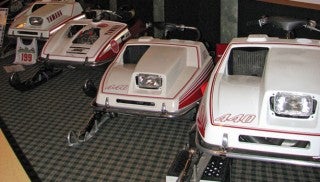
Yamaha's SRX proved a point in racing and on the trail
Although Yamaha officially entered the snowmobile market with its SL350 in 1968, the company didn’t become a player until its win at the Eagle River World Championships in 1971. Featuring Yamaha engines, new-fangled oil injection and lightweight construction; the Yamahas of the early 1970s mimicked the era’s best selling Ski-Doo Olympiques with rubber tracks and bogie suspensions. In racing Yamaha also competed with Ski-Doo, taking on the best Ski-Doo had too offer to beat the French-Canadian pioneers in that head-to-head 1971 World Championship showdown.
The mythology of that 1971 event lives on as what many call the best snowmobile race of all time. Why not? Ski-Doo’s headliner was Yvon Duhamel, a world-class motorcycle racer and championship snowmobile racer. Yamaha’s riders, Mike and Wayne Trapp, were a couple of cousins from Wisconsin. Ski-Doo’s racing budget was said to be more than a million dollars. Yamaha’s World Championship team rode with a smattering of support in engineers and factory backing.
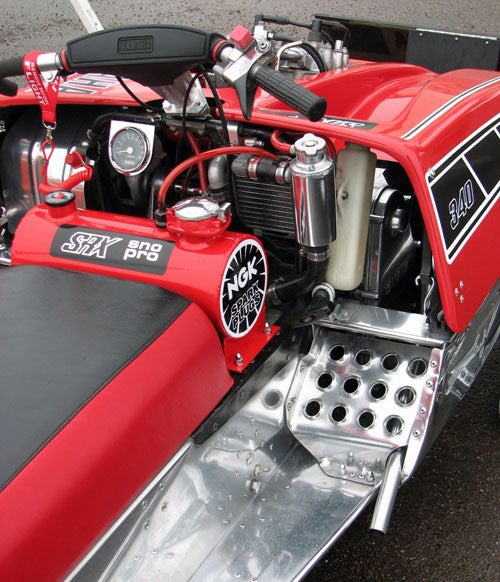 Yamaha’s mid-1970 SRX race sleds like this restored SRX 340 are much sought after classics.
Yamaha’s mid-1970 SRX race sleds like this restored SRX 340 are much sought after classics.What Yamaha took away from that 1971 Eagle River championship race was an instant David versus Goliath reputation for performance. The Yamaha engine was a mere 440 versus the nearly 800cc Rotax twin used in Duhamel’s Ski-Doo. The instant reputation held that the smaller sled was lighter, more maneuverable and as powerful as the factory Ski-Doo. Of course, we all love an underdog story and this one still resonates with Yamaha faithful.
Now & Then: Yamaha’s Historic Fours
Yes, the Yamaha was an underdog of sorts, but it had some sophistication that would carry into future Yamaha snowmobiles. The carbs were Keihin slide valves – fitted for an alcohol fuel blend, which added power. It has been estimated that the Yamaha 440 twin gave up only 10 to 15 horsepower overall to the Ski-Doo. Consider that 1971 Yamaha race engine used the latest in cylinder design and expansion exhaust tuners, concepts Yamaha learned with its Grand Prix racing motorcycles and brought to its snowmobile racer.
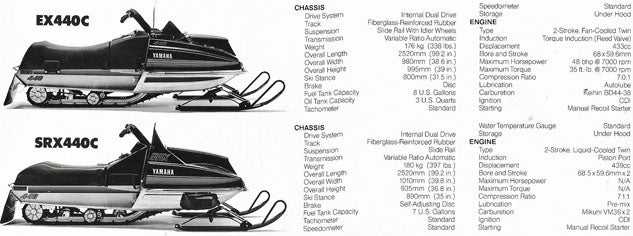 Yamaha hoped the excitement of its high-performance SRX would help push sales of its fan-cooled Exciter. While there were cross platform similarities, the performance difference was as great as an Apex versus Vector comparison is today.
Yamaha hoped the excitement of its high-performance SRX would help push sales of its fan-cooled Exciter. While there were cross platform similarities, the performance difference was as great as an Apex versus Vector comparison is today.Improved motorcycle-sourced cylinder designs, state-of-the-art tuned expansion chambers, alcohol fuel pumped through large capacity Keihin carbs and high revving engine technology helped the Yamaha twin to achieve close to 100 hp in a time when a racing 800cc free-air triple would put out 110-115 hp. Plus, the Yamaha enjoyed a lower and more forward placement of the engine versus the Blizzard’s tall positioning on the tunnel in the front of the driver. That helped immensely with the Yamaha’s handling.
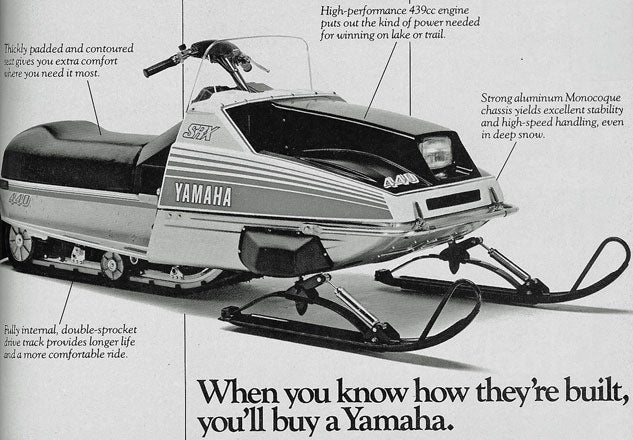 “When you know how they’re built…” advertisement to pointed out the major pluses of the SRX440.
“When you know how they’re built…” advertisement to pointed out the major pluses of the SRX440.While Yamaha won at Eagle River, it also won over consumers, who began taking a more serious look at Yamaha sleds. That Eagle River winning sled didn’t translate directly to a new 1972 trail model, but it did set the stage for the SRX series, a model name that has come and gone over the decades.
The Yamaha SRX with the 440cc twin has become one of the most sought after collector sleds in the sport. A 1977 SRX in excellent condition sold for US$5000 last December. Whether or not you have an SRX or want one, know that the SRX in its heyday underscored the concept of power-to-weight. According to the legend, the 1971 Eagle River winning Yamaha was said to nearly match the Ski-Doo Blizzard in that area. Ironically, Yamaha sadly has moved away from that concept with its current line of core models, except for the 500cc Phazers.
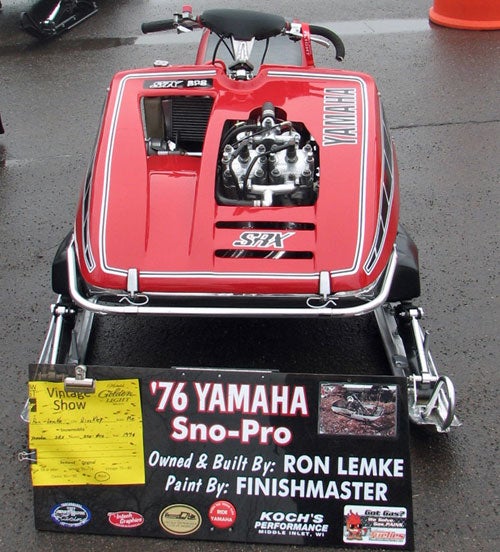 Serious collectors like Ron Lemke of Hinckley, Minn., put in many hours finding the correct parts and then piecing together a restoration like this 1976 Yamaha SRX Sno Pro.
Serious collectors like Ron Lemke of Hinckley, Minn., put in many hours finding the correct parts and then piecing together a restoration like this 1976 Yamaha SRX Sno Pro.By 1978 the SRX 440 featured a 439cc liquid-cooled twin that retailed for US$2,400. The engine that helped Yamaha dominate tracks across North America in 1977 had a specialized dual cooling system to keep engine performance consistent from race start to finish. The production 1978 version graduated to a seven-gallon fuel tank, up from the small racing tank fitted to oval racers, and the seat showed off thick padding and a new contoured shape for long range riding. Interestingly, although Yamaha pioneered its Autolube oil injection system as a standard feature on most Yamaha engines, the liquid-cooled 1978 SRX 440B used twin Mikuni 36mm float type carbs to deliver pre-mixed fuel. A Yamaha spokesman of the time noted the SRX “…develops twice as much horsepower as any of our other consumer sleds [and] we haven’t developed an Autolube system that puts out that much oil.” The SRX 440B was Yamaha’s first-ever liquid-cooled production sled and one of the few consumer trail sleds to use pre-mix fuel.
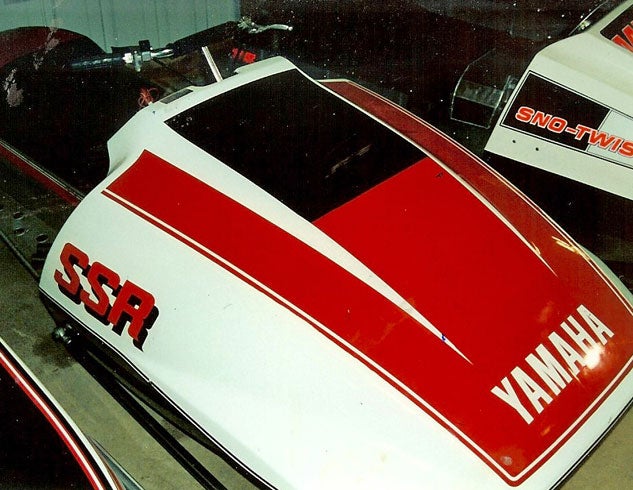 When Yamaha decided to go strong into super stock racing, the company created a pure stock racer that drew upon SRX experience but smoothed off the exterior for competition.
When Yamaha decided to go strong into super stock racing, the company created a pure stock racer that drew upon SRX experience but smoothed off the exterior for competition.This race-bred sled, with some changes, was destined to satisfy the call for a trail SRX as it had leaf spring skis with chromed shock absorbers and a wide 35-inch center-to-center ski stance for cornering. The rubber track measured 15 inches in width and 116 inches in circumference. Of course, unlike the fan-cooled trail sports Exciter, the liquid-cooled SRX needed a radiator and heat exchanger to help with cooling. It also used a high performance clutch based on the racing clutch and a CD ignition.
To take advantage of the 439cc engine’s claimed 80 horsepower, the chassis was what Yamaha referred to as a “Monocoque chassis,” with riveted aluminum tunnel and steel bulkhead to support the engine and clutches. Overall weight for the SRX was claimed to be less than 400 pounds without fuel.
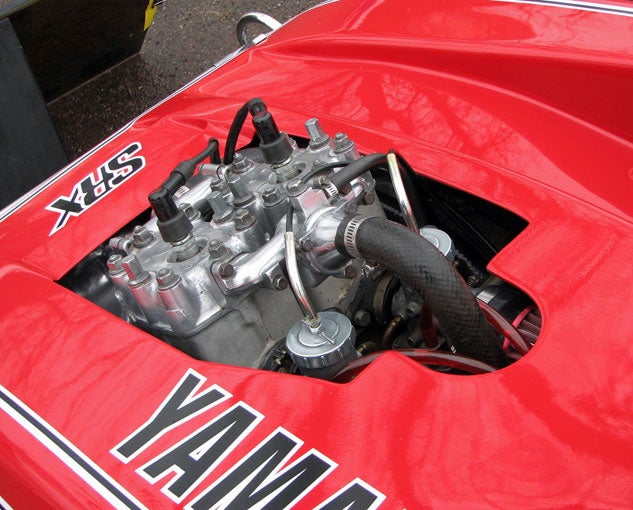 Yamaha’s 340cc Sno Pro SRX featured a liquid-cooled twin that poked over the hood line.
Yamaha’s 340cc Sno Pro SRX featured a liquid-cooled twin that poked over the hood line.One of the racing SRX’s most important roles was as a proving ground or tracked test bed for other Yamaha models. The Exciter series drew directly from the success of the SRX. Although fitted with fan-cooled engines, the Exciters shared styling and technologies. The drive and driven clutches were derived directly from the SRX. And, of course, the lightweight construction details helped provide excellent power-to-weight in a sled that claimed only 48 hp.
This was the sharing of performance that Yamaha continues into its model year 2016 sleds. Although the current Vector features an engine with one less cylinder and substantially less horsepower than the Apex, it shares component technologies like the front suspension, SingleShot rear suspension, Tuner skis, power steering and so on. You could say that Yamaha pioneered this sharing with the advent of the SRX and the racing models that preceded it.
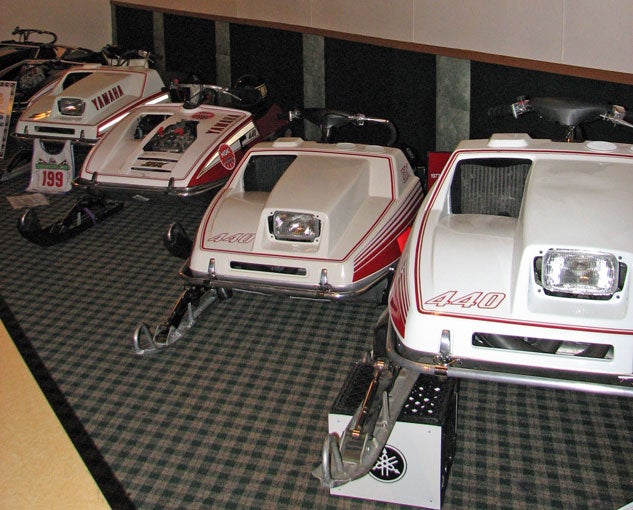 The SRX has achieved near cult status with collectors who enjoy showing off their restorations at various vintage snowmobile events like this one in Waconia, Minn.
The SRX has achieved near cult status with collectors who enjoy showing off their restorations at various vintage snowmobile events like this one in Waconia, Minn.Lightweight construction, carefully placed components and attention to power to weight struck a cord with snowmobile makers. After the “little” Yamaha embarrassed the “big” Ski-Doo 800, snowmobile manufacturers began downsizing from 800cc to a maximum of 440cc for championship classes, although a 650cc class continued on for a time. Ski-Doo fought back by developing an SRX-like sled of its own, the Ski-Doo TNT RV, which introduced rotary valve induction to trail performance snowmobiling in the mid-1970s. Like the Yamahas, the Ski-Doo RV was light, low slung and designed to be more trail racer than trail cruiser.
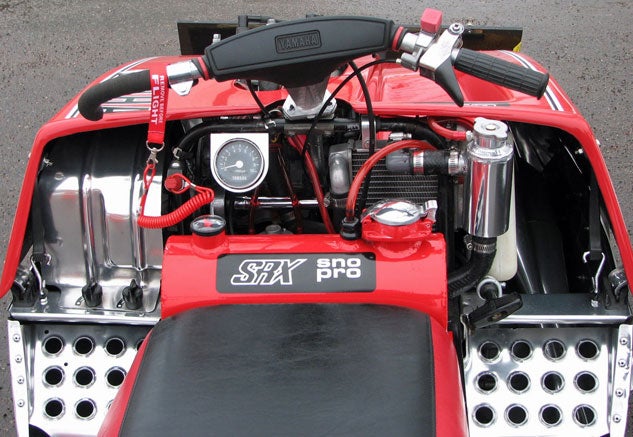 Yamaha’s SRX racers were all business as this driver’s eye view proves.
Yamaha’s SRX racers were all business as this driver’s eye view proves.With the impact of the 1971 Yamaha race win and the subsequent appearance of the SRX snowmobile, the snowmobile industry began a change for the better as sleds scored gains in lower weights, improved handling and straight line performance, albeit with smaller displacement engines that rivaled the power of the old big bores. Over time, of course, like most all snowmobiles since the 1970s, the SRX grew heavier in order to comply with mandated sound and emission requirements.








 Your Privacy Choices
Your Privacy Choices